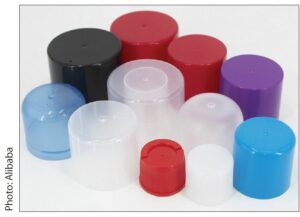Written on: October 1, 2022 by Nicholas Georges
Recycling is a critical topic—and one that I’ve written about for SPRAY many times. However, one area that I’ve not yet addressed is the marketplace for the production of new manufactured products. While empty aluminum and steel aerosol containers have robust end markets with an increasing demand for more material, that isn’t the case for all materials that can be recycled.
In the U.S., when there’s a discussion around recycled content, we focus on post-consumer recycled (PCR) content. PCR material is what consumers provide to their local recycling program that then gets sorted, processed and eventually turned into new material. However, recycled content, when not specified to be PCR, can also include pre-consumer recycled content or post-industrial recycled content.

Last April, I visited a company called Constellium that recycles aluminum from various sources and turns it into new materials that can be used to manufacture new products. We discussed the potential of including empty aluminum aerosol containers within used beverage container (UBC) bales. It was there that I saw firsthand why companies that recycle materials prefer post-industrial material to post-consumer. Post-industrial material is typically cleaner (less contamination), is a more consistent source of material and is more cost-effective to collect.
For these reasons, post-industrial material is a preferred source. This is why, in the U.S., environmentalists are pushing specifically for PCR and not just recycled content minimums. This will help ensure that consumer waste doesn’t just end up in landfills. There are plenty of markets for material such as aluminum and steel, so recyclers are pushing for more material, whether post-industrial or post-consumer; however, this isn’t the case for all material types, such as plastic.
You’ve probably heard different numbers for the recycling rate of plastic materials. The U.S. Environmental Protection Agency (EPA) reportsi it at 8.7%, while the U.S. Dept. of Energy statesii 5%. Unfortunately, there isn’t a competitive market for most plastic waste streams because recycled plastic is generally used as a substitute for virgin, meaning its price needs to be similar to virgin. However, the price for virgin plastic doesn’t fully reflect the costs of collecting, sorting and processing recycled material. Additionally, mechanically recycled plastic can’t be used at all, or used at high levels, in certain applications due to quality concerns. If we could resolve these issues, there would be a greater demand for recycled plastic material and companies would figure out how to source and recycle plastic at much higher rates because of the high return on investment.
Individual companies have voluntary minimum recycled content requirements that they are trying to meet for their plastic packaging. Those commitments should be applauded and will certainly drive the end-market for those recycled materials. Here in the U.S., in order to further spur end-market growth for recycled content, several States have passed legislation requiring minimum PCR content in various types of plastic. California, Colorado, New Jersey and Washington State have (or are currently) developing different sets of PCR requirements within their laws, and it’s already created a complicated patchwork of requirements with different scopes, timelines and PCR content minimum percentages.
Beyond the patchwork of regulatory challenges, the bigger question is whether there will be sufficient supply to meet the PCR requirements. Earlier this year, the Independent Commodity Intelligence Services conducted a surveyiii on the uncertainties of industry’s ability to source enough material to meet these requirements, as well as lingering questions regarding the economics. These drivers may force companies to make hard decisions on whether to comply or pay the fines associated with noncompliance. However, this isn’t just a challenge in the U.S. Earlier this year, Canada conducted a consultationiv around the development of minimum content regulations for plastic items and stakeholders in Europe are pushingv for a minimum of 30% recycled content in plastic packaging.
For any reader that manufactures aluminum or steel packaging, or uses aluminum or steel packaging as the primary material in your end-use products, you may be wondering if there’s any activity around mandates for your package. The answer—at this time—is No, not in the U.S. at least. However, as plastic PCR laws are implemented across the country, the focus will inevitably shift away from plastic and onto other types of material.
From an advocacy standpoint, it’ll be critical to be prepared to discuss what is technologically and economically feasible and what is not. I would encourage you all to take a look at your internal processes, or talk with your supply chain, to understand the current and potential future capabilities for all your packaging needs. Find out what their current PCR levels are and if they are exploring ways to increase that amount. Are there technological challenges to increasing the amount of PCR in your package if government were to mandate higher minimums? Is there enough supply of recycled content if every company were to start requiring more PCR? If not, what can be done to improve the recycling of your package so that material can be used again in a future product? It doesn’t hurt to be proactive in asking these simple questions while there’s no mandate for your material and you still have time.
For more information or to discuss this further, please contact me at ngeorges@thehcpa.org. SPRAY
————————————————————————————————————————————————
i link
ii Milbrandt, A., Coney, K., Badgett, A., Beckham, G.T. (2022). Quantification and evaluation of plastic waste in the U.S. Resources, Conservation & Recycling. Vol. 183.
iii link
iv link
v link